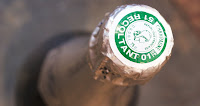Trying to read Champagne label sometimes is like scene James Bond de-codes secret password in 007 movies but one of the key terms worth remembering is RM, which stands for Recoltant-Manipulant, meaning grower producer, who owns the vineyard and makes own Champagne.
I recently tasted three RM Champagne of Aubry, Gaston Chiquet and Pierre Peters. All three are small production and well-made, each expressing its individual personality.
Aubry
"Earthy", "natural" and "rustic" come to my mind every time I taste Champagne from Aubry. Established in 1790, Aubry is located in the Petit Montagne de Reims and it is run by twin brothers of Pierre and Philippe. It is a small property but full of innovation. Majority of base wine is from low-yield vineyards and vinified in old 205 liter oak barrels. This is also one of very few producers who still make Champagne from ancient varieties of Pinot Gris, Arbanne and Petit Meslier.
The one I tasted was the "Classic"(40% Pinot Meunier/30% Pinot Noir/ 30% Chardonnay) from the Premier Cru site of Jouy-les-Reims. It was golden in color with copper/brassy tint with nose of baked pear and apple, citrus with nutmeg, white pepper and a touch of nutty/ caramely maple syrup note. On the palate, the aromas found on the nose were expressed with granny smith apple-like lively acidity with great depth and earthiness.
I often find hints of mushroom and dried leaf in Champagne of Aubry and it reminds me of mushroom hunting in a forest stepping on dry leaves in the fall.
Gaston Chiquet
Claude Chiquet and his two sons manage this property, which holds vineyards in Dizy, Ay, Cumieres and Hautvillers. Gaston Chiquet is known for its Blanc de Blancs (100% Chardonnay) from Ay, the village famous for Pinot Noir. (another property I know who does something so radical is Henri Giraud, also located in Ay)
The fruit for NV Traditional (45% Pinot Meunier/ 35% Chardonnay/ 30% Pinot Noir) is from the Premier Cru village of Dizy, bordering Ay with south-west exposure and altitude of 100-200 meters. Rich fruit consists of apple, pear and Meyer lemon, followed by hints of honey, toasty and creamy notes of hazelnut as well as fresh note of very gentle leafy herbal twist. It is beautifully balanced by good amount of fresh acidity on the palate. This Champagne presents clean forward fruit with a class.
Pierre Peters
Pierre Peters is located in one of the 17 Grand Cru villages of Mesnil-sur-Oger, the area known to produce top quality Chardonnay. When young, the wine from this village shows notes of herb, lemon and chalk and with age, it evolves to mocha and nuts. Because of its strong personality, the base wine is generally used for blending with other villages. However 6th generation of Pierre Peters only uses Chardonnay producing impressive collection of Blanc de Blancs (100% Chardonnay)from vineyards of Mesnil-sur-Oger, Oger, Avize, and Cramant (all Grand Cru villages located in the Cote des Blancs)
"Cuvee Reserve" exhibited great elegance featuring clean citrus fruit with hints of delicate white flower, chalky mineral, followed by crisp lemon fruit and focused acidity on the palate partnered by creamy soft texture. On the back palate, I tasted hints of honey, acacia, candied ginger and white pepper. Since there is big contrast from fresh citrus fruit on the front palate and more of rich and warm toasty notes on back palate, it created a kind of illusion like experience.
I drank this with take-out sushi, which is one of my absolute favorite pairings (other favorite parings includes: oysters, especially kumamoto, caviar and Cape Cod potato chips) Bite of sesame seeds echoed beautifully with nuttiness and toastiness of Champagne, crisp acidity cut the fishiness and saltiness of tobiko (tiny fish eggs) and chalky minerality complemented its flavors. Creamy texture matched the fattiness of avocado. Fresh citrus fruit brought out the sweetness in soft shell crab tempura, which came inside Spider maki. I have also read in somewhere the quality Champagne acquires from ageing process both on less (or yeast autolysis) and in the bottle complements the flavor of soy sauce, which is also a product of fermentation.
One thing I found common in these three high quality Champagne besides they are all from RM, is that they also indicated the date of disgorgement (process of removing the yeast sediment from the bottle) Despite many people have told me non-vintage Champagne does not improve after the disgorgement process and should be consumed as soon as possible, many of the producers I met in Champagne told me the opposite.
Well, it is really a matter of personal taste but if you prefer fresh fruit with crisp acidity, then enjoy a bottle as soon as you purchase but if you prefer more mature fruit with toasty and nutty quality, then choose the one with more time (or hold if you have combination of time, patience and good cellaring environment). However finding the date of disgorgement is very unlikely in mass-produced big name Champagne. On the other hand, there are quality conscious producers like these three I tasted, who take time and care to indicate the date on each back label. Other producers who also mention the disgorgement date are: Bruno Paillard, Phillipponnat and Egly-Ouriet.
It is not always easy to find RM here in "brand-driven" US Champagne market but if you see a bottle, try it instead of reaching over to the usual suspects, for example the one with a bright yellow label or initial DP. I hope you get to discover and experience the real magic of RM Champagne this holiday season. A votre sante!







No comments:
Post a Comment